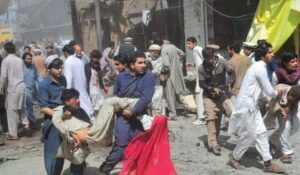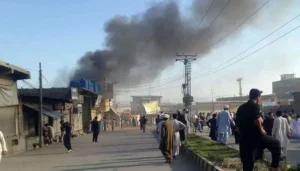For the past nine days, the Kurram district in Khyber Pakhtunkhwa, Pakistan, especially its headquarters, Parachinar, has been engulfed in fierce tribal clashes. These recent clashes have thrust the city into the international spotlight as it became the epicenter of a violent sectarian conflict between the Sunni and Shia communities in the region, that has left dozens dead and hundreds injured. What may have begun as a land dispute, has rapidly evolved into a complex situation, also drawing attention to the region’s troubled history and current challenges.
Historical Background

Kurram District, previously known as Kurram Agency, is located in Pakistan’s Khyber Pakhtunkhwa province and has long been known for sectarian violence between Shia and Sunni communities. This history of conflict has resulted in numerous casualties over the years. The recent surge in violence has been concentrated in Parachinar, a city within the district that lies on the border with Afghanistan. The clashes reportedly began approximately nine days ago and have since expanded to six different areas within the district.
Despite widespread claims on social media labeling the unrest as a sectarian conflict, emerging reports suggest that the underlying cause of the clashes is a land dispute among local tribes rather than religious sectarianism. The dispute reportedly centers around a piece of common property shared by multiple tribes, with some factions claiming exclusive rights to the land. Such disputes have traditionally been addressed through local jirgas (tribal councils) or government intervention. However, these conflicts have a tendency to persist and escalate, often leading to violent confrontations.
What is Happening Now?
The recent outbreak of violence has also reported the use of heavy weaponry, including missiles and rockets. Social media reports suggest that missiles were fired at Parachinar city and Sada, escalating the conflict to an unprecedented level. The use of heavy weaponry in the conflict indicates the severity of the situation and raises questions about the proliferation of arms in the region as well.
According to media reports, at least 36 people lost their lives with 162 more sustaining injuries in armed confrontations between two tribes in Pakistan’s volatile tribal district.

The situation in Parachinar is further complicated by its geographical location. Sharing a border with Afghanistan, this city in the Kurram region of Khyber Pakhtunkhua makes it vulnerable to cross-border influences. Some online sources also claim that Taliban fighters are involved in the conflict, although these reports remain unconfirmed.
The suspension of internet and mobile phone services in the region by the State, has complicated efforts to get accurate information about the region in real time leading to further confusions and miscommunication online.
Impact on the community
The impact of the clashes on the local population has been severe. The closure of the main highway has effectively halted the flow of goods and people, causing significant disruptions to daily life and isolating communities already under strain. Local healthcare facilities are overwhelmed by the influx of injured individuals. Medical staff are struggling to provide adequate care, with reports indicating that hospitals and pharmacies have run out of essential medicines. This shortage is particularly dire given the high number of injuries resulting from the armed clashes.
This situation has been further compounded by the suspension of internet and mobile phone services in the region. This has cut off crucial lines of communication for the residents, leaving them vulnerable and disconnected from the rest of the world. The information vacuum has allowed rumors and unverified claims to spread on social media, potentially exacerbating tensions and hindering efforts to de-escalate the conflict.

Ambiguities surrounding the Parachinar Conflict
Local authorities have stated that the conflict initially arose from a land dispute. However, narratives circulating on social media have framed the violence in sectarian terms. Some users have labeled the situation as a sectarian war between Shia and Sunni communities, with a few even describing it as a genocide against the Shia population. The communication blockade imposed by the state, along with limited coverage by national media, has made it challenging to verify these claims. Consequently, the true nature of the clashes and the accurate number of casualties and injuries remain uncertain. There has been no official confirmation regarding the specifics of the dispute, adding to the confusion and uncertainty surrounding the situation.
Government Response
MNA Engineer Hameed Hussain has underscored the dire situation in local healthcare facilities, highlighting the urgent need for medical supplies and support While a Member of Provincial Assembly, Mr. Ali Hadi Irfani has called on the government to take immediate action to enforce a ceasefire and prevent further violence. At the national level, Senator Allama Raja Nasir Abbas Jafari, Chairman of Majlis Wahdat Muslimeen Pakistan, has criticized the provincial government and law enforcement agencies for their failure to restore peace and protect the population.
Thus, what began as a land in the region, has evolved into a multifaceted conflict with potential sectarian violence. This development has brought to light the deep-seated tensions and governance challenges in the province. As the situation continues to unfold, it is imperative for local and national authorities to address not only the immediate violence but also the underlying issues that have allowed such conflicts to persist through decades.
Click Reformistan Instagram for more updates
Related Stories
















